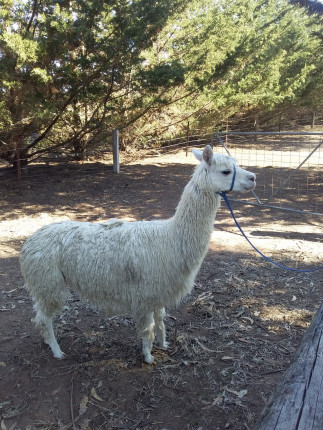How our Alpaca headstalls (harness, bridle, lead or halter) came into being
Summer time at Lakes Entrance, on the South East coast of Victoria, Australia, is a very busy time. When city folk arrive here, ready to relax and enjoy their summer vacation, the locals at this sea-side town are rolling up their sleeves to be sure that the best of service and entertainment is available for the six weeks of holidays.
Here at Bungalook Alpaca Farm, just out of town, we had an idea for involving our alpacas in the fun. People want to learn about the bush, enjoy picnics, and just love alpacas. Perhaps we could take visitors on alpaca escorted bush walks, with a neat little pack on each animal to carry a simple picnic for small family groups.

I made up a set of packs and with the help of our grandchildren we began leading our alpacas down through the paddock, across the bridge, through the rain forest, up the hill and home again. The alpacas were a bit reluctant at first, but soon settled into their practice walks. It all seemed trouble free, so we invited our neighbours to lend themselves to the experiment. They were happy to oblige, and brought their grandchildren to join in.
To our surprise and consternation, we found that our tractable, placid alpacas didn’t like the newcomers and strongly objected to the children. We had failed to recognise the difference between people who have been alpaca trained and those who have not.
The animals could spot the difference instantly and reacted with alarm. We did the walk; the neighbours enjoyed themselves, but the alpacas certainly did not. They behaved badly, pulling on their leads and lurching about, trying to stay as far away as possible from the new people. It seemed we would have to introduce many strangers to our animals before they would resign themselves to being handled by the uninitiated.
The most worrying aspect of this experience for us was to see the discomfort caused by the headstalls that we had always used (an Alpaca headstall is a bridle or halter attached to a lead). We had always regarded headstalls on alpacas as something of a problem, particularly in the early stages of training young animals. Every alpaca owner must be familiar with the problem of nose bands pulling on soft tissue when placed too far down the nose, or side straps riding too high on small heads and putting pressure on eyes. In the hands of inexperienced people, these problems were amplified, so it seemed we needed a better headstall before we could begin.
We have had a long association with horses, and for many years trained the youngsters that we bred here at Bungalook. One of the basics of training a young horse is to have a good understanding of the animals body structure and centre of gravity. This awareness gives the trainer an advantage over an animal that is far more powerful than any human. The horse has a strong body, rectangularly based, with a leg on each corner, making him very powerful in forward or backward motion. Because of his elongated base, sideways movement is less stable, more awkward. If we place our control rope at the head end of his long, flexible neck, and keep our body positioned at 90 degrees to the horse’s spine, we can fairly easily pull him off balance if he begins to struggle. He is soon convinced that we have hidden powers and that struggling is fruitless.. If we move our control rope to the end of his long, bony head, we multiply the leverage effect. That is why headstalls for horses are designed the way they are, with the point of contact being as far along the neck-head lever as possible. This design has simply been moved across for use on other animals, so all headstalls look pretty much the same.
Consider then, the alpaca. Still rectangularly based, with a long flexible neck, but with a very small delicate head at the end. Do we need to take advantage of the lever effect by involving that sweet little head in the equation? I think we do not: a lead rope on the neck is all that is needed. All we need to do is find a way to keep the lead in position at the top end of that elegant neck.
We began experimenting with carefully shaped leather straps and found that the alpacas agreed wholeheartedly with the theory.Leading is a much more enjoyable activity if there is no pressure on the head at all. We invited more neighbours to come alpaca walking with us and found that although the animals sometimes rudely objected to the strangers, the new headstalls caused no discomfort on tender eyes and noses and offered every bit as much control as the old standard ones did. The new design can even be used on two and three week old cria, so they are able to learn leading at an age when it causes them the least aggravation, trotting happily along side the mother with a tiny headstall fitted neatly onto the little head. Now we make them of a lightweight, synthetic material that is easily washed.
Having solved the alpaca headstall (harness, bridle, halter, lead) problem to our satisfaction we looked again at the summer that was shaping up to be the longest, hottest, driest that we had seen for quite a while, so taking people and animals for walks in the bush was not looking so pleasant. We decided to shelve the idea for a cooler, greener season, and settle back into making our headstalls in the cool of our house.
This story is history now. We have been making and selling these headstalls (harness, bridles, halters, leads) for a number of years, sending them off to people in many countries.
We never did get around to organising the Alpaca Picnics that triggered the idea.
